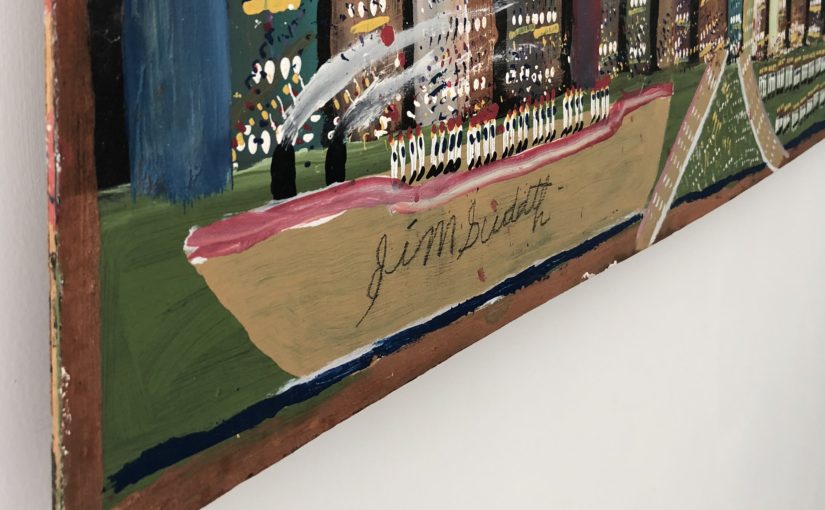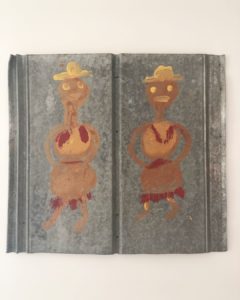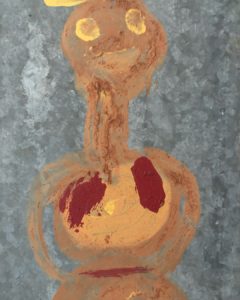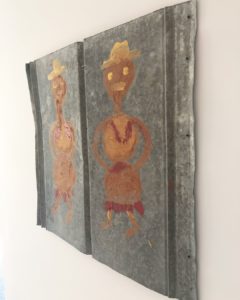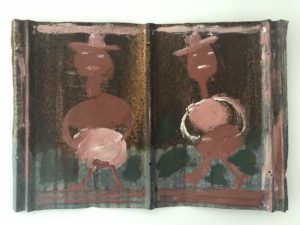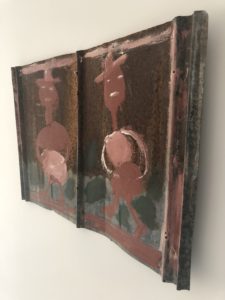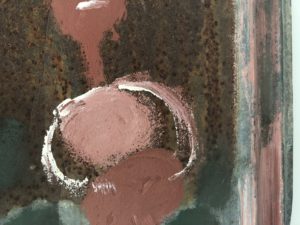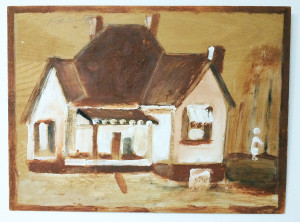1910 – 2007, Alabama
“Whhooooweee!!!”
Hooting and slapping his knee, Jimmy Lee Sudduth laughs as he tells the story of one of the many people that have come to see him in his native Fayette over the years. “And boy, she was pretty too! Looked just like her.” he says, pointing to Karen. Joined by Seebo, Jimmy’s cousin and caregiver, we’re sat in Jimmy’s studo in 1998, surrounded by paintings, buckets of mud, and paint, keeping cool from the 98 degree weather outside. “That one’s called Jack & Jill, “Jack & Jill went up the hill!” he sings and then laughs again.
 Born March 10, 1910, Jimmy Lee Sudduth used his native Alabama mud to make pictures starting at age 3. His work, typified by his unique “sweet mud”, came to the attention of collector’s as early as the 1960’s. As a child, Jimmy Lee discovered that by mixing molasses with mud he could create paintings on tree stumps that would endure the elements. He eventually perfected his methods, augmenting the red Alabama mud with natural pigments found in grass, shrubs, berries and bark. His subjects range from chickens and gators, to grand Southern houses and portraits of women (his favorite subject!). His work is in major folk and contemporary art collections and the Smithsonian.
Born March 10, 1910, Jimmy Lee Sudduth used his native Alabama mud to make pictures starting at age 3. His work, typified by his unique “sweet mud”, came to the attention of collector’s as early as the 1960’s. As a child, Jimmy Lee discovered that by mixing molasses with mud he could create paintings on tree stumps that would endure the elements. He eventually perfected his methods, augmenting the red Alabama mud with natural pigments found in grass, shrubs, berries and bark. His subjects range from chickens and gators, to grand Southern houses and portraits of women (his favorite subject!). His work is in major folk and contemporary art collections and the Smithsonian.
“When I was three years old I went out to with woods with my mother. She was a medicine woman and would go out to collect herbs and stuff. One day I got some mud on my hands and used it to paint a picture on a tree stump. When I went back a few days later it was gone. Then I man let me mix up some molasses with the mud, and that was it! I can use honey, syrup, even this diet Pepsi. Make’s it all sticky so the mud won’t come up. Guaranteed!”
In the 1970’s Jimmy’s mud paintings were gaining the attention and recognition of dealers and collectors. In 1975 Jimmy was one of two to represent Alabama at the American Folk Festival, playing his harmonica for a crowd of “seventy thousand people!” His paintings have evolved as he has grown older. Jimmy lays claim to identifying 36 different shades of mud, and he uses natural pigments such as grass and berries, rubbed onto his paintings, to add colour. In the 1990’s he began to use acrylics to add colour to his paintings, not able to venture out to collect his pigments. Jimmy passed away in 2007.
Jimmy’s paintings depict everyday images of life in rural Alabama, scenes of cities that he has visited, his dog Toto (and Toto 2, who has replaced his much loved companion), many self-portraits and grand old houses.
“See those little people there,” he says, pointing to the bottom of the painting entitled New Orleans. “Ain’t no one else can paint people that small. No one! I’ve been painting all my life, before any of those art people came along. I know I was good, I make pictures better than anyone! Come here and give me some sugah. Whhooooweee!!!”
– Marcus Piña, Garde Rail Gallery

